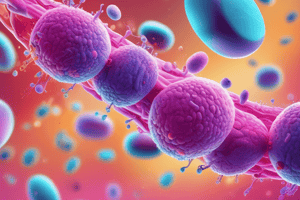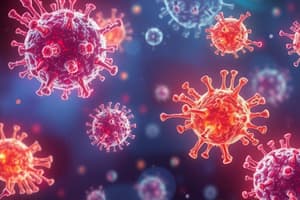Podcast
Questions and Answers
What is the role of β-lactamases in bacterial resistance?
What is the role of β-lactamases in bacterial resistance?
- They degrade β-lactam antibiotics, providing multi-resistance. (correct)
- They make bacteria more susceptible to antibiotics.
- They are produced only in Gram-positive bacteria.
- They enhance the activity of β-lactam antibiotics.
What is a key characteristic of selective toxicity in antibiotics?
What is a key characteristic of selective toxicity in antibiotics?
- They inhibit the formation of viral particles.
- They target bacterial cell wall components without harming human cells. (correct)
- They are effective against all types of bacteria.
- They are equally harmful to human cells as they are to bacteria.
What is the primary purpose of determining the Minimum Inhibitory Concentration (MIC)?
What is the primary purpose of determining the Minimum Inhibitory Concentration (MIC)?
- To determine the efficacy of bactericidal antibiotics.
- To establish the lowest concentration that inhibits bacterial growth. (correct)
- To find the highest concentration of an antibiotic that kills bacteria.
- To identify the concentration at which bacteria begin to grow.
Which of the following is NOT a mechanism of antimicrobial resistance?
Which of the following is NOT a mechanism of antimicrobial resistance?
What role does D-alanyl-D-alanine play in bacterial cell wall synthesis?
What role does D-alanyl-D-alanine play in bacterial cell wall synthesis?
What characterizes a mutation in bacterial genetics?
What characterizes a mutation in bacterial genetics?
Which of the following best describes the function of β-lactam antibiotics?
Which of the following best describes the function of β-lactam antibiotics?
Which antimicrobial agent is associated with toxicity problems affecting the bone marrow?
Which antimicrobial agent is associated with toxicity problems affecting the bone marrow?
Which of the following is responsible for induced mutations?
Which of the following is responsible for induced mutations?
How does the closeness of MIC to MBC affect the classification of an antibiotic?
How does the closeness of MIC to MBC affect the classification of an antibiotic?
What is the result of autolytic enzyme activation in bacteria during cell wall synthesis inhibition?
What is the result of autolytic enzyme activation in bacteria during cell wall synthesis inhibition?
What defines an auxotroph in the context of mutations?
What defines an auxotroph in the context of mutations?
What is the primary consequence of thymine-thymine dimers caused by UV radiation?
What is the primary consequence of thymine-thymine dimers caused by UV radiation?
What distinguishes the peptidoglycan synthesis in bacteria from human cells?
What distinguishes the peptidoglycan synthesis in bacteria from human cells?
Which class of antibiotics is known for potential side effects related to hearing and kidney damage?
Which class of antibiotics is known for potential side effects related to hearing and kidney damage?
What is the effect of microbial resistance on the clinical management of infections?
What is the effect of microbial resistance on the clinical management of infections?
What is the primary outcome of inhibiting protein synthesis in bacteria?
What is the primary outcome of inhibiting protein synthesis in bacteria?
Which statement about spontaneous mutations is correct?
Which statement about spontaneous mutations is correct?
What component is typically absent in human cells that is present in bacteria's cell wall synthesis?
What component is typically absent in human cells that is present in bacteria's cell wall synthesis?
Which outcome is most likely if a pathogen's enzymes are very similar to host enzymes?
Which outcome is most likely if a pathogen's enzymes are very similar to host enzymes?
What role does genetic recombination play in bacteria?
What role does genetic recombination play in bacteria?
What are the primary effects of inappropriate antibiotic use in bacteria?
What are the primary effects of inappropriate antibiotic use in bacteria?
Which of the following statements correctly outlines a mechanism of action for inhibiting nucleic acid synthesis?
Which of the following statements correctly outlines a mechanism of action for inhibiting nucleic acid synthesis?
Which type of radiation is known to induce higher mutation rates in bacteria?
Which type of radiation is known to induce higher mutation rates in bacteria?
Which characteristic is NOT essential for an effective antimicrobial agent?
Which characteristic is NOT essential for an effective antimicrobial agent?
What is the main distinction between bactericidal and bacteriostatic antibiotics?
What is the main distinction between bactericidal and bacteriostatic antibiotics?
Which of the following sources is considered a natural antibiotic?
Which of the following sources is considered a natural antibiotic?
Which statement about antibiotics is false?
Which statement about antibiotics is false?
What is a potential consequence of antibiotic misuse?
What is a potential consequence of antibiotic misuse?
Which classification of antibiotics is specifically characterized by activity against a selective group of bacterial types?
Which classification of antibiotics is specifically characterized by activity against a selective group of bacterial types?
Which of the following is true regarding the stability of antimicrobial agents?
Which of the following is true regarding the stability of antimicrobial agents?
What is the primary function of antibiotics derived from fungi?
What is the primary function of antibiotics derived from fungi?
What is the result of ionizing radiation such as X-rays on biological molecules?
What is the result of ionizing radiation such as X-rays on biological molecules?
Which statement accurately describes the process of transformation in bacteria?
Which statement accurately describes the process of transformation in bacteria?
Why are Rec A proteins significant in bacterial transformation?
Why are Rec A proteins significant in bacterial transformation?
In which of the following bacteria does transformation primarily occur?
In which of the following bacteria does transformation primarily occur?
Which statement is true regarding the differences between transformation and conjugation?
Which statement is true regarding the differences between transformation and conjugation?
What happens to the naked DNA after it is internalized by a competent recipient bacterium during transformation?
What happens to the naked DNA after it is internalized by a competent recipient bacterium during transformation?
What role do nuclease enzymes play in the process of transformation?
What role do nuclease enzymes play in the process of transformation?
What is a common misconception about the types of genetic exchange mechanisms in bacteria?
What is a common misconception about the types of genetic exchange mechanisms in bacteria?
What role does the Rec A protein play in bacterial transformation?
What role does the Rec A protein play in bacterial transformation?
Which factor does NOT affect the process of transformation in Gram-negative bacteria?
Which factor does NOT affect the process of transformation in Gram-negative bacteria?
What is defined as the ability of a bacterium to take up DNA from its environment?
What is defined as the ability of a bacterium to take up DNA from its environment?
Which of the following statements is true regarding the transformation process?
Which of the following statements is true regarding the transformation process?
What happens during step IV of the transformation process?
What happens during step IV of the transformation process?
Which of these bacteria are known to typically exhibit natural competence?
Which of these bacteria are known to typically exhibit natural competence?
Which statement about DNA transformation in bacteria is incorrect?
Which statement about DNA transformation in bacteria is incorrect?
What specific protein produced by competent bacteria aids in the uptake of DNA?
What specific protein produced by competent bacteria aids in the uptake of DNA?
Flashcards
Antimicrobial Agent
Antimicrobial Agent
A substance that targets and kills or stops the growth of microorganisms, which are harmful living organisms such as bacteria that cause infection.
Bacteriostatic
Bacteriostatic
A type of antimicrobial agent that specifically targets bacteria and prevents or stops their growth.
Bactericidal
Bactericidal
A type of antimicrobial agent that specifically targets bacteria and kills them.
Narrow Spectrum Antibiotic
Narrow Spectrum Antibiotic
Signup and view all the flashcards
Broad Spectrum Antibiotic
Broad Spectrum Antibiotic
Signup and view all the flashcards
Natural Antibiotics
Natural Antibiotics
Signup and view all the flashcards
Synthetic Antibiotics
Synthetic Antibiotics
Signup and view all the flashcards
Selective Toxicity
Selective Toxicity
Signup and view all the flashcards
Peptidoglycan
Peptidoglycan
Signup and view all the flashcards
Transpeptidase
Transpeptidase
Signup and view all the flashcards
D-ala-D-ala
D-ala-D-ala
Signup and view all the flashcards
Beta-lactam antibiotics
Beta-lactam antibiotics
Signup and view all the flashcards
Inhibition of cell wall synthesis
Inhibition of cell wall synthesis
Signup and view all the flashcards
β-lactamase
β-lactamase
Signup and view all the flashcards
Minimum Inhibitory Concentration (MIC)
Minimum Inhibitory Concentration (MIC)
Signup and view all the flashcards
Minimum Bactericidal Concentration (MBC)
Minimum Bactericidal Concentration (MBC)
Signup and view all the flashcards
Antimicrobial Resistance
Antimicrobial Resistance
Signup and view all the flashcards
Mechanisms of Antibiotic Resistance
Mechanisms of Antibiotic Resistance
Signup and view all the flashcards
Multi-Drug Resistance
Multi-Drug Resistance
Signup and view all the flashcards
Mutation
Mutation
Signup and view all the flashcards
Spontaneous Mutation
Spontaneous Mutation
Signup and view all the flashcards
Induced Mutation
Induced Mutation
Signup and view all the flashcards
Auxotroph
Auxotroph
Signup and view all the flashcards
Genetic Recombination in Bacteria
Genetic Recombination in Bacteria
Signup and view all the flashcards
Conjugation
Conjugation
Signup and view all the flashcards
Transposon
Transposon
Signup and view all the flashcards
Transformation
Transformation
Signup and view all the flashcards
Bacterial Transformation
Bacterial Transformation
Signup and view all the flashcards
Competence
Competence
Signup and view all the flashcards
Competence Factor
Competence Factor
Signup and view all the flashcards
DNA Degradation
DNA Degradation
Signup and view all the flashcards
Rec A Protein
Rec A Protein
Signup and view all the flashcards
Successful Transformation
Successful Transformation
Signup and view all the flashcards
Induced Competence
Induced Competence
Signup and view all the flashcards
Genetic Exchange
Genetic Exchange
Signup and view all the flashcards
Competent bacterium
Competent bacterium
Signup and view all the flashcards
Transformant
Transformant
Signup and view all the flashcards
Merozygote
Merozygote
Signup and view all the flashcards
Transduction
Transduction
Signup and view all the flashcards
Specialized transduction
Specialized transduction
Signup and view all the flashcards
F+ bacterium
F+ bacterium
Signup and view all the flashcards
Study Notes
Antibiotics & Bacterial Genetics
- Antibiotics are chemicals used to treat infections. They either kill pathogens or stop their growth.
- Different types of antibiotics target different pathogens (bacteria, viruses, parasites, fungi)
- Antibiotics must not harm the host, and should not cause allergic reactions.
- They need to be stable in storage, and last long enough in the body to be effective.
- The goal is to kill pathogens before they develop resistance.
Antimicrobial Agents
- Antimicrobial agents kill or inhibit the growth of pathogens.
- They must not harm or cause allergic reactions to the host.
- They need to be stable (solid or liquid), and reach effective concentrations in the body.
Antibiotics - Classification
- Classified by their activity (bacteriostatic, bactericidal), spectrum (narrow, broad), and mechanism of action (inhibit cell wall synthesis, protein synthesis, nucleic acid synthesis, or membrane function).
- Bacteriostatic antibiotics prevent bacterial growth.
- Bactericidal antibiotics kill bacteria.
- Narrow-spectrum antibiotics target specific types of bacteria.
- Broad-spectrum antibiotics target a wider range of bacteria.
Antibiotics - Sources
- Some antibiotics are naturally produced by microorganisms (fungi, bacteria -actinomycetes)
- Others are synthesized in laboratories, chemically related to natural antibiotics.
Antibiotics - Classification III.According to absorbability
- Locally Acting: These affect a single part or organ of the body.
- Systemically Acting: These affect the whole body.
Antibiotics - Classification IV.According to Mechanism of Action
- Inhibiting bacterial cell wall synthesis.
- Altering cell membrane function and permeability.
- Inhibiting protein synthesis.
- Inhibiting nucleic acid synthesis.
Antibiotic Spectrum of Activity
- Effectiveness varies based on the type of microbe. No antibiotic works against all microbes.
- Different classifications of microbes are targeted by different antibiotics (e.g., prokaryotes, eukaryotes, specific types of bacteria)
Mechanisms of Antimicrobial Action
- Bacteria have their own enzymes for cellular functions (cell wall formation, protein synthesis, DNA replication, RNA synthesis, and essential metabolic processes).
- Antimicrobials may target these processes.
Inhibition of Cell Wall Synthesis
- Cell wall synthesis is a target for some antibiotics.
- These antibiotics interfere with the synthesis of peptidoglycans (the major component of bacterial cell walls) either directly or indirectly.
Inhibition of Protein Synthesis
- Targeting bacterial ribosomes or other protein synthesis mechanisms.
- Some antibiotics block initiation, elongation, or termination steps of protein synthesis in bacteria.
Selective Toxicity
- Antibiotics should selectively target bacterial processes while leaving host cells unharmed.
- Bacteria have unique characteristics that make them different from human cells, offering targets for antibiotic action.
Mechanisms of Antibiotic Resistance
- Resistance can be caused by mechanisms such as enzymatic breakdown of the antibiotic, changes in its target site, decreased penetration into the bacterial cell, or efflux pumps eliminating the antibiotic.
Antimicrobial Resistance
- Microbes can become resistant to antibiotics, making them ineffective.
- The relative or complete lack of an antibiotic´s effect on previously susceptible microbes, or increased minimum inhibitory concentrations (MIC).
What Factors Promote Antimicrobial Resistance?
- Exposure to sub-optimal levels of antibiotics or to microbes that carry resistance genes.
- Inappropriate use of antibiotics (e.g., incorrect prescriptions, use of antibiotics against viral infections, or use without medical supervision).
- Conditions in hospitals also can promote resistance.
Bacterial Genetics (Mutation & Recombination)
- Bacteria can develop resistance through genetic mutations or recombination processes.
- Mutations are heritable changes in DNA.
- Recombination is a process for recombining genetic material between donor and recipient.
Mutation
- Spontaneous and induced mutations can lead to antibiotic resistance.
- Mutations are changes in the nucleotide sequence of a gene sequence in DNA.
- They are usually detrimental, but they may also lead to beneficial changes and to the requirement of new nutrients.
Radiations as Mutagens
- Non-ionizing (e.g., UV rays)
- Ionizing (e.g., X-rays, gamma rays)
- Both types of radiation may damage DNA and lead to mutations.
Genetic Recombination (Bacteria)
- Genetic recombination is the transfer of genetic material from one organism to another.
Other Mechanisms of Genetic Recombination in Bacteria
- Transformation
- Transduction and Conjugation.
- Mechanisms which can move genes between bacteria or DNA fragments between cells.
Transformation
- Transformation is a method of genetic recombination in which naked DNA from a donor bacterium moves into a competent recipient bacterium and is incorporated into the recipient bacterium's chromosome.
Transduction
- Gene transfer mediated by bacteriophages (viruses that infect bacteria).
Conjugation
- Direct transfer of genetic material between bacteria through physical contact. Plasmid transfer.
- One bacterium acts as a donor of the plasmid (F plasmid), and the other acts as a recipient.
- Different types - F+ and Hfr conjugation
Bacterial Plasmids
- Small, circular DNA molecules that are separate from the main bacterial chromosome.
- Can carry genes for antibiotic resistance
Studying That Suits You
Use AI to generate personalized quizzes and flashcards to suit your learning preferences.





